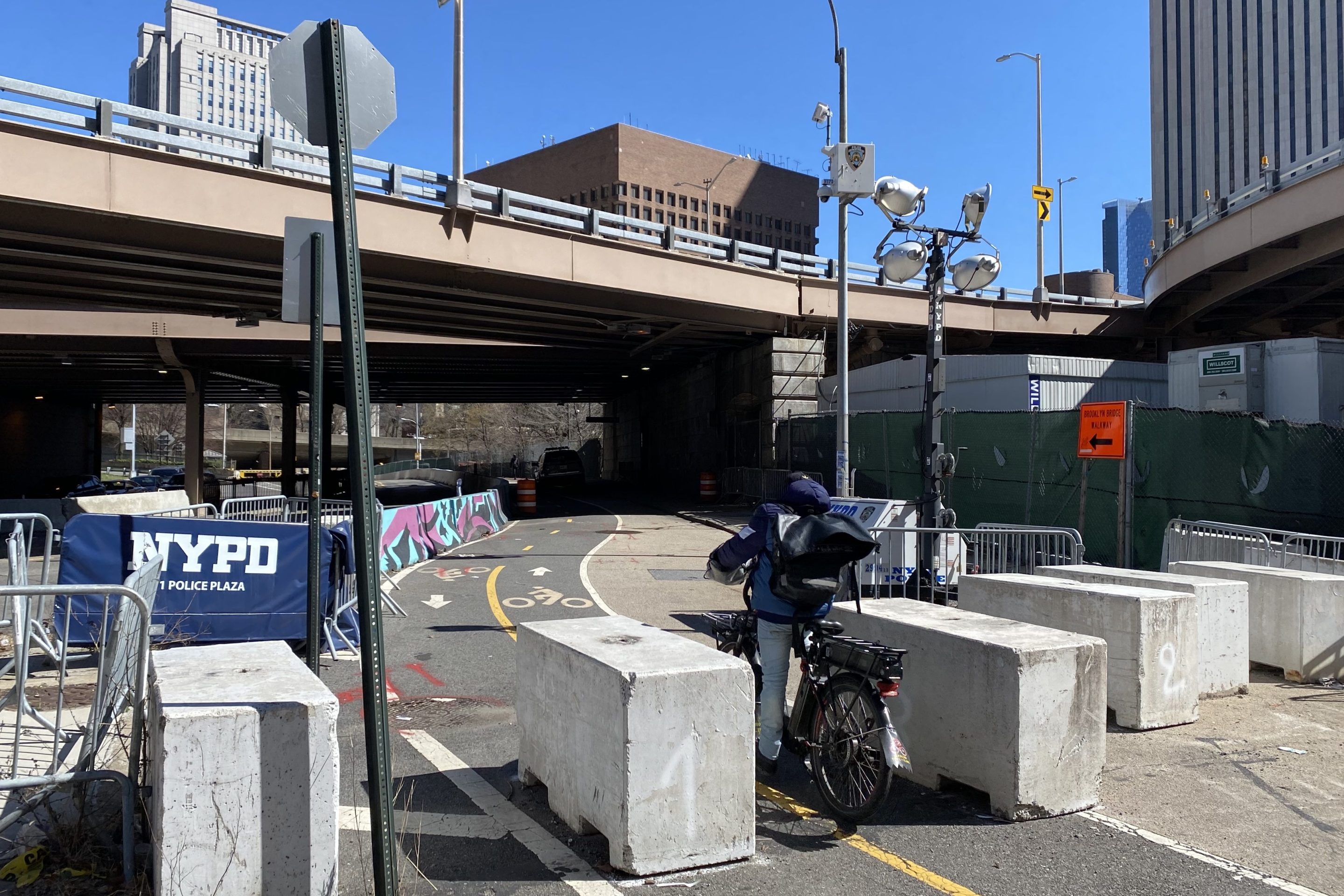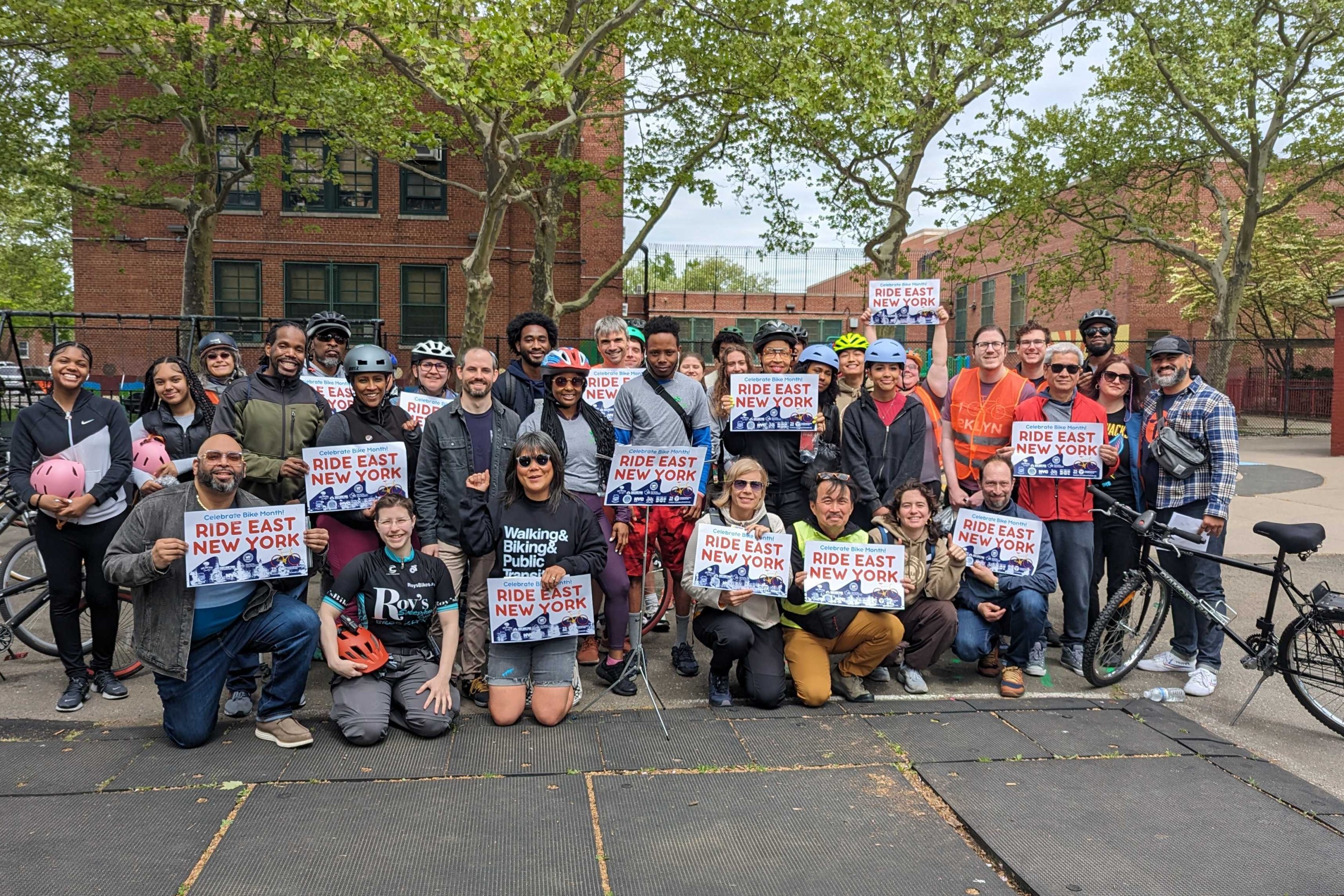Here’s One Way to Fix Citi Bike So It Doesn’t Only Serve Rich People Who Already Live Near Subways
4:11 PM EDT on July 10, 2019
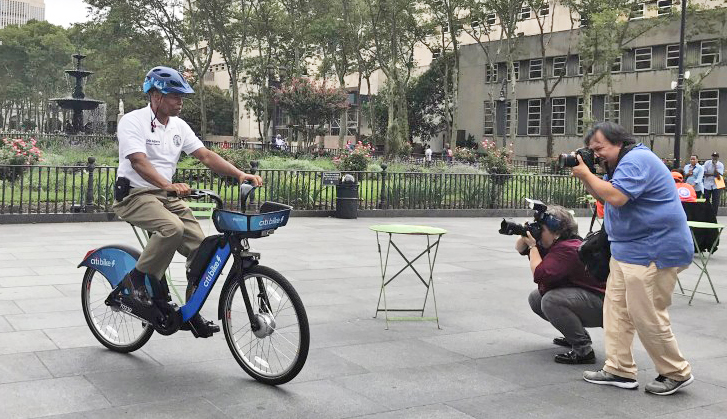
Brooklyn Borough President Eric Adams on a Citi Bike . File photo: Gersh Kuntzman
Citi Bike serves mostly rich white people. All you need to do is look at the coverage map to see that.
But that shouldn't be your only takeaway from a new report from New York City Communities for Change, an activist group that is calling on the city to ensure that Citi Bike lives up to its promise of equity when it announces its long-awaited expansion this summer.
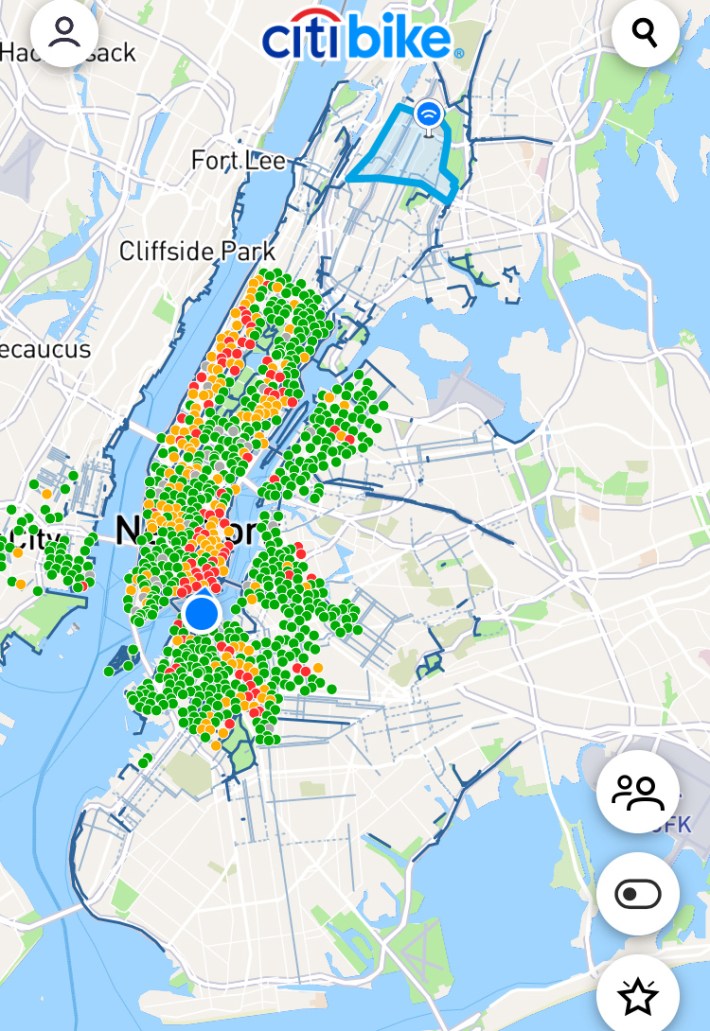
The report [PDF] is not a stinging indictment of Citi Bike — but it is a reminder of how many more low-income, subway-deprived people the supposedly public bike share system could be helping outside the current coverage area in Manhattan and thin slices of gentrified Brooklyn and Queens.
Roughly 20 percent of New Yorkers without access to bike share live in poverty, but that figure drops to 15.9 percent for New Yorkers with Citi Bike, the report said. "Meanwhile, three-quarters of neighborhoods in extreme poverty are located outside the Citi Bike service area," it added.
So with equity as the focal mission, the report identified roughly 760,000 "disproportionately poor and non-white New Yorkers without good subway access who would benefit from an equity-focused bike sharing network expansion" — most of whom live in The Bronx and Queens.
The report's proposed expansion zones are an effort to merge two partially independent factors: bringing Citi Bike to "disadvantaged" neighborhoods and using Citi Bike to increase access to transit in neighborhoods where the nearest subway station is a long walk away. To determine the best way to do that, the authors constructed a "vulnerability index" based on an area's median household income, percentage of the population living in poverty, the percentage of the population which are people of color, and the percentage of the population without a bachelor’s degree.
When it comes to the "vulnerability index," the zones needing immediate Citi Bike expansion are clear: Adding bike share to four neighborhoods in the Bronx, plus Crown Heights and Brownsville in Brooklyn, would give more than 300,000 vulnerable people access to Citi Bike.

Looking only at subway access as a metric, the report focuses on five neighborhoods that aren't exactly transit deserts, but where many residents "do not currently live close enough to a subway station to make daily commuting viable," according to the report. Those areas are Jackson Heights/Flushing, the Central Bronx, Crown Heights/Brownsville, Jamaica and Bushwick/Ridgewood — and expanding Citi Bike there would also help about 300,000 people (some of whom are the same people in the other study group). [One flaw worth pointing out: Bushwick/Ridgewood made it onto this list even though only 12 percent of the residents in those neighborhoods have long walks to the subway. By comparison, nearly 40 percent of residents in the Jackson Heights/Flushing zone have a long walk to transit.]
Fusing those disparate needs — helping the poor while also boosting access to transit — led to the recommendation of 12 "priority neighborhoods for bike sharing expansion" (see map below):
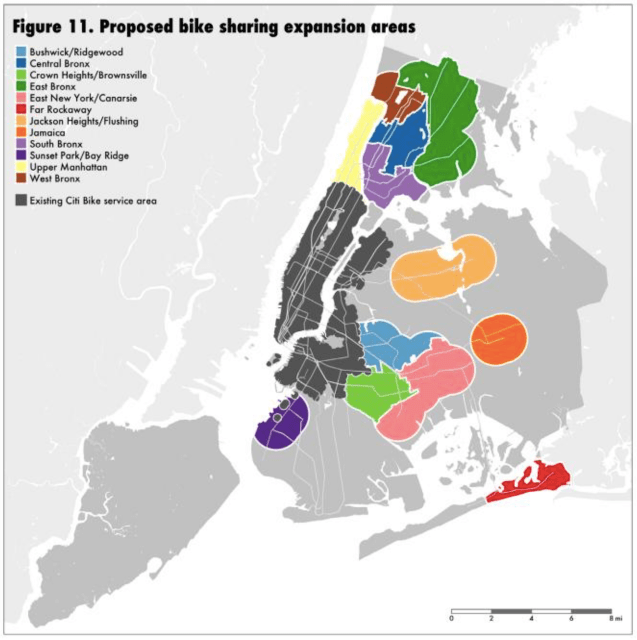
Other areas on the map — such as Sunset Park and Upper Manhattan — were included because of their high "vulnerability" on the index, although both areas have relatively few residents with long walks to the subway.
Obviously, there are other factors that the Department of Transportation — which is responsible for choosing where Citi Bike expands — are likely considering before it announces the next zone, which is expected this month. Given that Citi Bike is a subscription service that has to earn a profit, the company might want to prioritize maintaining a contiguous footprint so that new neighborhoods immediately become adopted into the Citi Bike family, if you will.
There's also the issue of dockless Citi Bike, which are being tested in a small portion of the north Bronx. It is unclear if dockless and docked systems will operate together. Other companies, including Uber's JUMP and Lime Bike, are operating dockless systems in the Rockaways and part of Staten Island under a DOT pilot. Those pilots might also expand.
And, most important, the Department of Transportation is responsible for building out the network of protected bike lanes. So far, the city has kept Citi Bike's coverage zone more or less contained to areas with the best and safest bike infrastructure. But, of course, that's a chicken and egg thing — the DOT could have expanded the bike network into underserved and impoverished communities years ago, paving the way for more Citi Bike equity. If DOT decides to only expand Citi Bike to neighborhoods with the safest bike infrastructure, this will be a slow expansion indeed.
For its part, Citi Bike said that equity is a key goal of the Lyft-owned bike-share system.
“Ensuring that diverse communities have access to Citi Bike is central to our mission," said company spokeswoman Julie Wood. "And as we expand significantly in the near future, we will reach many more neighborhoods and continue our focus on bike share equity.” (The company says that 3,000 Citi Bike subscribers are taking advantage of the $5-per-month memberships available to residents of public housing or recipients of food stamps. There are 150,000 Citi Bike members overall.)
Streetsblog reached out to the Department of Transportation with specific questions about the future expansion zone, but the queries were ignored in favor of this statement, which we are reproducing in full:
We look forward to the forthcoming expansion of Citi Bike, bringing additional geographic and demographic diversity to its coverage area and ridership. This follows expansion in recent years into communities such Harlem, Bushwick, and Red Hook as well as a dockless bike pilot in the Bronx. Please note when the program launched in NYC for the first time back in 2013 it was operationally important that this occurred in very dense parts of Manhattan and Brooklyn.
It is worth noting that the term "operationally important" relates to Citi Bike's ability to function — i.e. make a profit — without any public subsidy — a Bloomberg-era arrangement that many call the original sin of Citi Bike. As such, Citi Bike remains the only form of mass public transit that is not significantly underwritten by the public. Transit systems as diverse as the MTA's bus network and the mayor's ferry system do not operate by the profit motive and, therefore, do not choose their coverage areas based solely on what is "operationally important" to the fiscal bottom line.
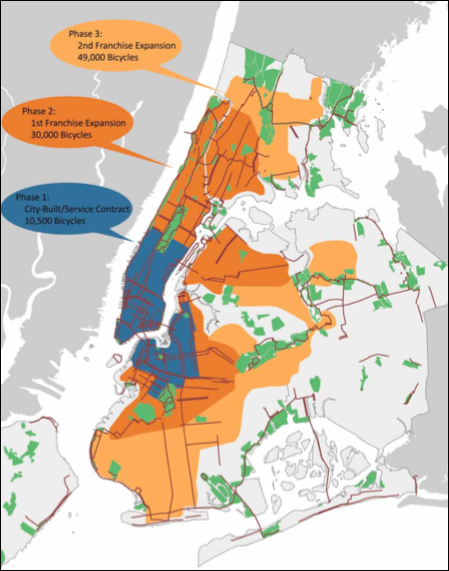
Waiting in the wings is the expansion itself. Way back in November, the city announced that Citi Bike's footprint would double to 65 square miles as the system added 28,000 bikes to the current 12,000-bike fleet over the next five years. That huge announcement was followed by ... silence.
"The New York Communities for Change report is all well and good, but the mayor announced that the system is supposed to grow — that policy exists — yet we've heard nothing for eight months," said Jon Orcutt of the advocacy group Bike NY and a former Bloomberg administration transportation official. "At 40,000 bikes, you could have a system with the same density as you do now, but covering the entire city that is currently served by the subway."
Orcutt also said that the most important factor in expansion is maintaining a contiguous service area.
"Building little pods of isolated bike share is a recipe for failure," he said.
Orcutt referred Streetsblog readers to a map (right) created by the Department of City Planning in 2009 that offered a different take on Citi Bike expansion, albeit with 49,000 bikes instead of 40,000. Still, the broad coverage area is decidedly different from the one pushed by New York Communities for Change.
"The 2009 map was focused solely on density of people, which is why it basically follows the subway," Orcutt said.
The lead author of the New York Communities for Change study did not disagree that contiguous zones are helpful — but they're mostly helpful to bike share companies that need to make a profit.
"The model in New York has been a city-granted monopoly to Citi Bike. If that’s the framework, the economics favor the contiguous zone," said David Wachsmuth, a professor at the McGill University School of Urban Planning. "But there are other ways to offer the public service of bike share. The city could prioritize what it wants and it can choose to not prioritize contiguous coverage areas."
Wachsmuth also emphasized that his report was fundamentally focused on a central premise: the most efficient ways to expand bike share to people who need it the most.
"The map from 2009 would be a very good way to do bike sharing, but that has not been the way it has been done," he said. "We are many years out from when the system opened, but it still serves mostly well-off areas. Even if Citi Bike were to expand as that map suggests, the areas in our expansion zone won’t be served for quite some time." If at all.
And since equity is the focus, the time is now, according to New York Communities for Change — formerly ACORN.
“Citi Bike needs to look like the city it serves, plain and simple," said Jonathan Westin, the group's executive director. "This report shows Citi Bike has failed to bring bike sharing to the parts of the city that can use it most — communities of color, low-income neighborhoods and people living in transit deserts. The city has to take a serious look at what a company that has been operating with a virtual monopoly has been doing and move quickly to fix it."
Here's another thing thing to consider: Who funded the New York Communities for Change report? Officially, NY Communities for Change said the report "was commissioned and funded by New York Communities for Change. The authors from the School of Urban Planning, McGill University, are exclusively responsible for all analysis, findings, and conclusions."
But a Streetsblog source is convinced some funding came from bike and scooter-share companies that are eager to get a piece of New York's market, but currently cannot operate inside Citi Bike's monopoly coverage area or anywhere else for that matter unless the city creates a pilot program, as it did in Staten Island and the Rockaways.
Here's the report. Read it all for yourself:
New York Communities for Change Citi Bike Report by Gersh Kuntzman on Scribd
Gersh Kuntzman is editor in chief of Streetsblog NYC and Streetsblog USA. He also writes the Cycle of Rage column, which is archived here.
Read More:
Stay in touch
Sign up for our free newsletter
More from Streetsblog New York City
City Considers Fixes for Another Ridiculously Slow Cross-Bronx Bus
Potential bus improvements are on the table for the Bronx's Tremont Avenue, but the Adams administration's failures on nearby Fordham Road loom large.
DOT Unveils First Step for Park Row Redesign
The city hopes to make Park Row more appealing to residents and visitors. But the real work is years off.
Monday’s Headlines: East New York’s New Bikes Lanes Reduced Crashes Edition
Initial results show East New York's protected bike lanes made Cozine and Wortman avenues safer. Plus more news.
Stockholm Leader’s Message to NYC: ‘Congestion Pricing Just Works’
"In Stockholm, people really thought that congestion pricing would be the end of the world, the city will come to a standstill, no one would be able to get to work anymore and all the theaters and shops would just go bankrupt. None of that happened."
Friday’s Headlines: Trump Trial Trumps Safety Edition
Is anyone going to bother to fix the dangerous mess on the streets and plazas around the Trump trial? Plus more news.

